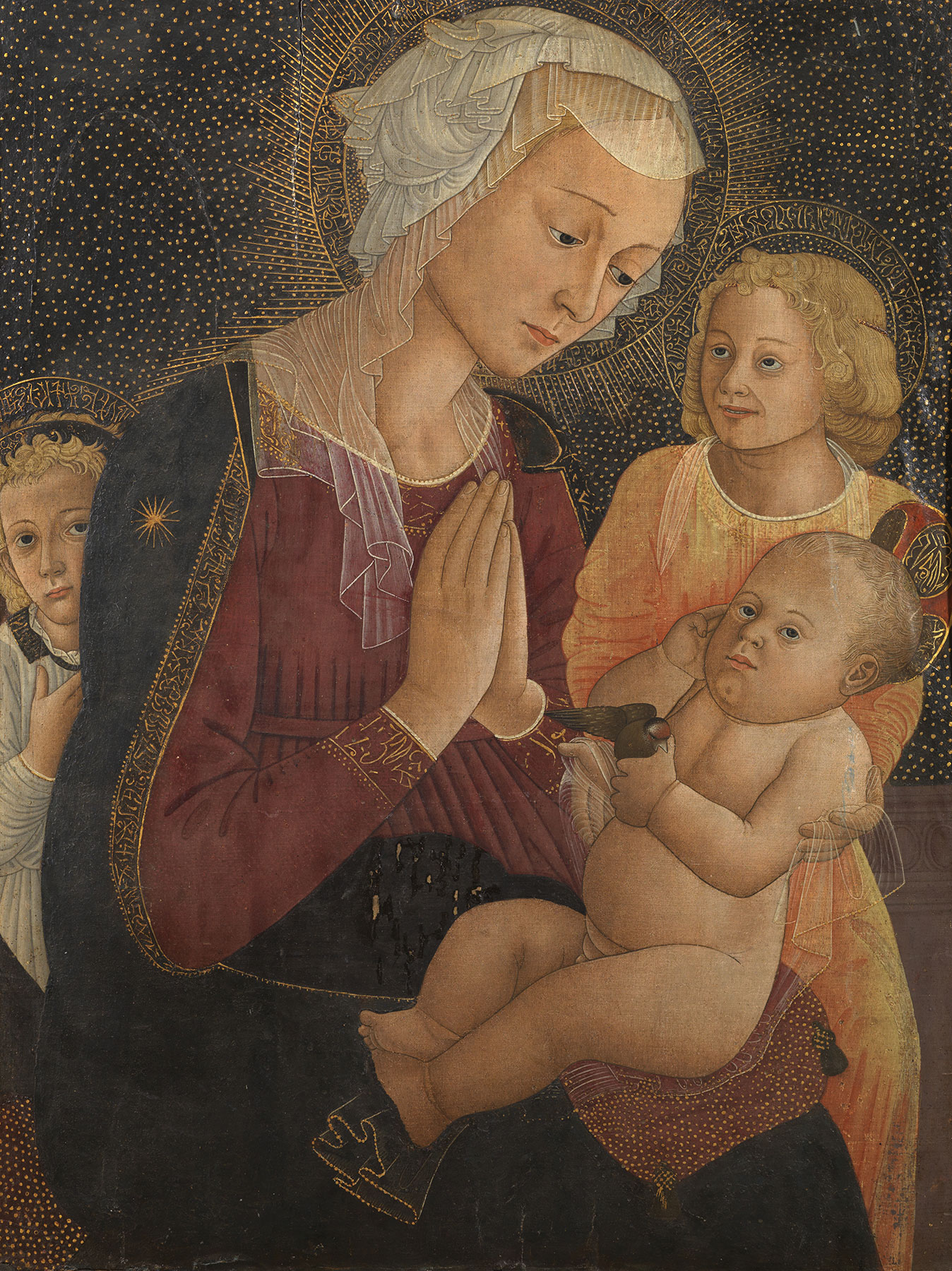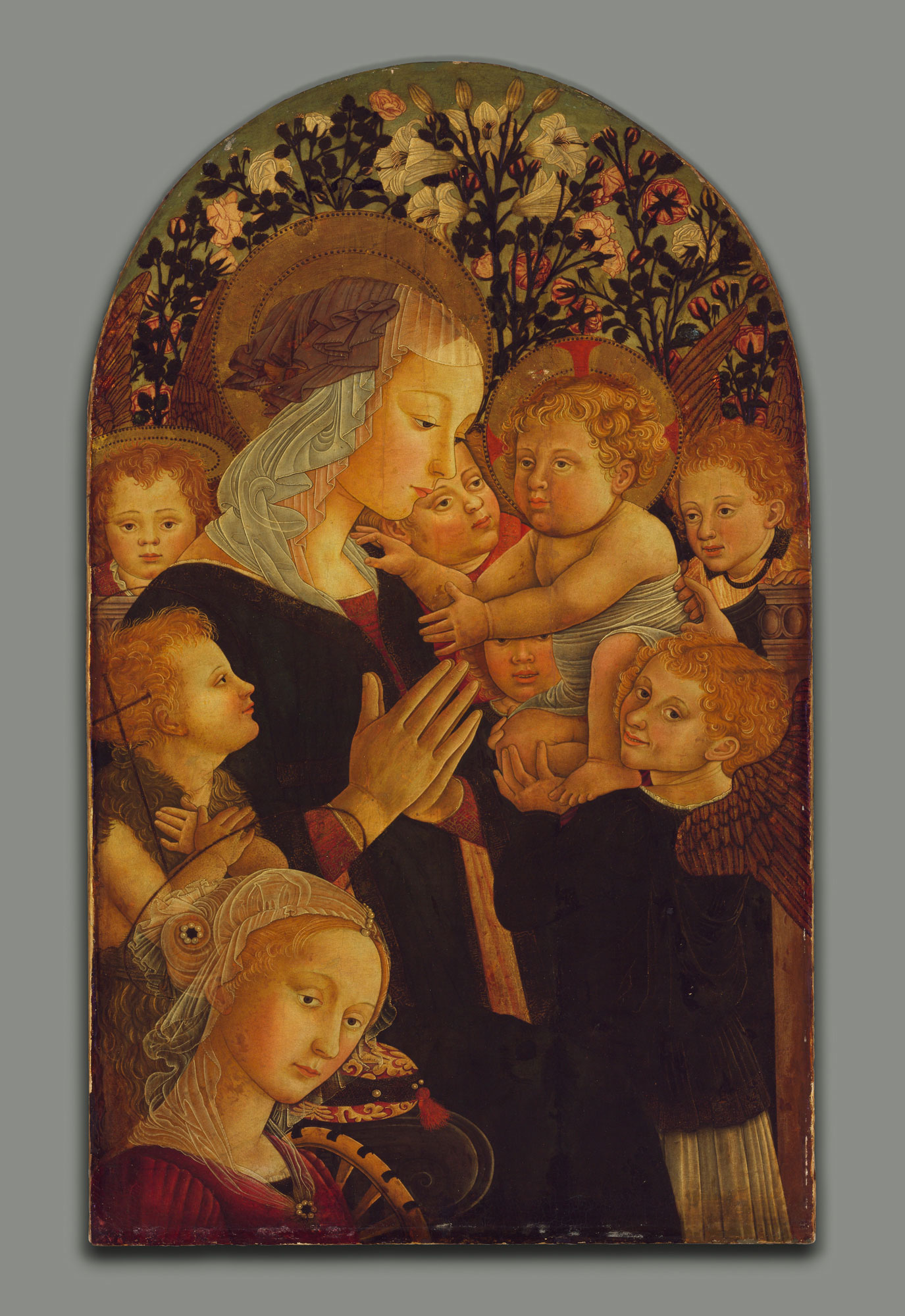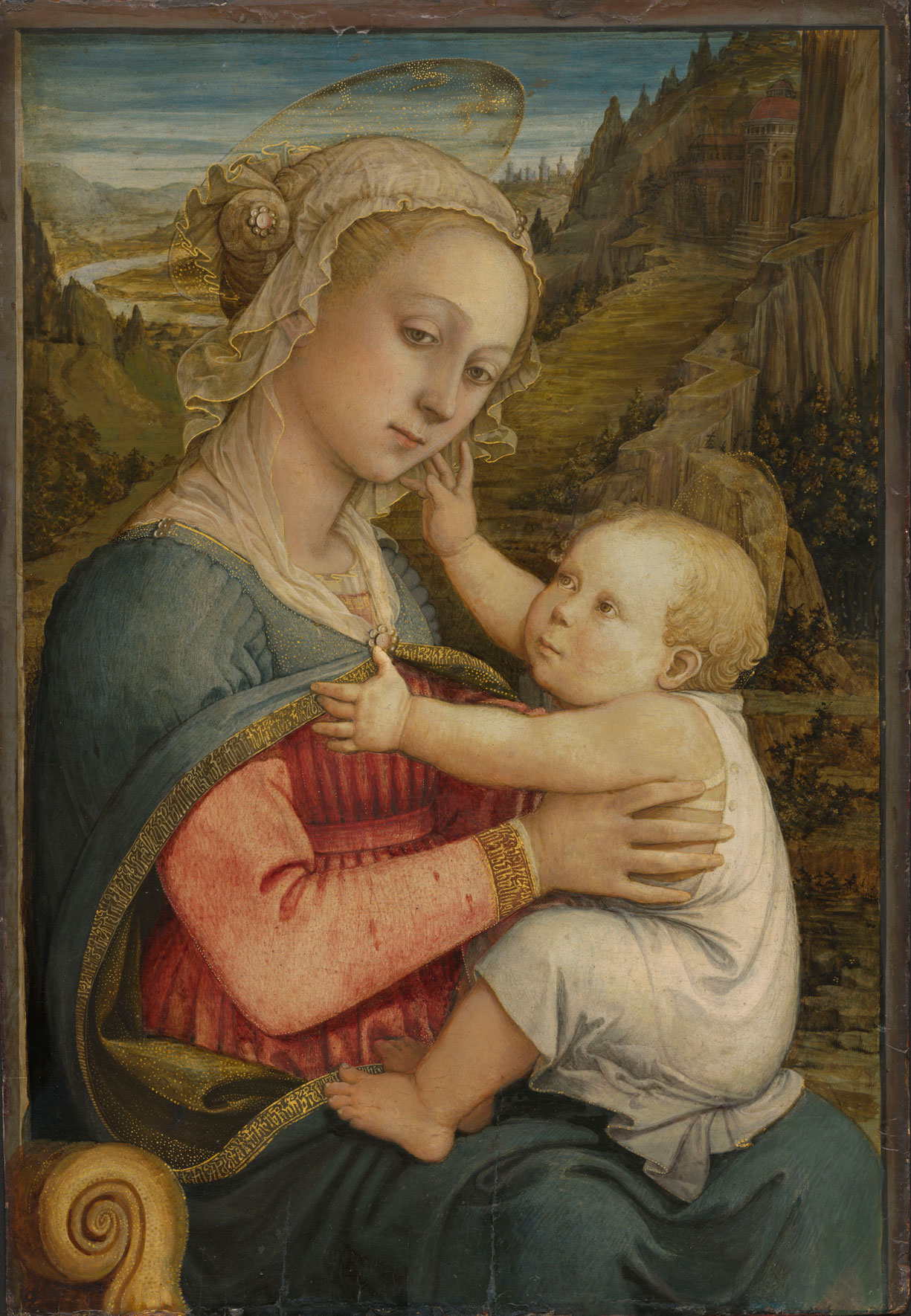James Jackson Jarves (1818–1888), Florence, by 1859
The panel support, of a vertical wood grain, is 3 centimeters thick and uncradled. It is composed of three planks measuring 19, 29, and 26.5 centimeters in width, from right to left, to which are applied the moldings defining the sloping sight edge of the frame, 3.5 centimeters thick, and additional top moldings, 2.5 centimeters thick. The base moldings of the frame and the antependium are separate elements, carved from horizontally grained sections of wood. The top anthemion attachment is a modern replacement, as is the bottom finial of the antependium. The entire structure was partially and harshly cleaned in a treatment by Andrew Petryn of 1965–66 that stripped all original surfaces off the right half of the frame, exposing the wood support on the lower right and preparatory layers of gesso and color elsewhere. The rope molding eliding between the paint surface and the sight edge of the frame was also removed at that time, except for the section lining the arched top of the composition. The gold ground and rose hedge background of the painted scene are well preserved, but the paint surface otherwise is severely abraded. Patches of old discolored varnish remain on the darkened blue draperies at the Virgin’s shoulders and on her left cuff.
Following uncritical repetition by Russell Sturgis, Jr., and William Rankin of James Jackson Jarves’s attribution for this painting to Fra Diamante, which was, in any event, a generally accurate gauge of its style, Bernard Berenson listed it in the second edition of his Florentine Painters of the Renaissance as by the artist he identified as Pier Francesco Fiorentino.1 The group of paintings he assembled around this name was always acknowledged to be coherent but was later recognized not to be by the artist who left this signature on a series of altarpieces in the territory of San Gimignano, leading F. Mason Perkins to coin the epithet Pseudo-Pier Francesco Fiorentino.2 Perkins’s correction was subsequently embraced by Berenson and is still largely in vogue today.3 A variant descriptor, “Lippi-Pesellino Imitators,” was coined by Federico Zeri in 1958 to indicate a more precise stylistic orientation for the group and a less positive assertion that it is the product of a single artist.4 Both terms are used interchangeably to refer to the same paintings.5
Although its style and handling are typical of paintings in the exceptionally large group of works attributable to the Pseudo-Pier Francesco Fiorentino, the Jarves tabernacle is unusual among them both for its scale and for its composition. Megan Holmes has demonstrated that the overwhelming majority of paintings in this group derive the principal figures of their compositions from perhaps a dozen prototypes identifiable as works either by Filippo Lippi or Francesco Pesellino.6 The main group of the Virgin, the Christ Child, and the angel supporting Him in the Jarves tabernacle, however, appears in only one other work by the Pseudo-Pier Francesco Fiorentino, a smaller and somewhat later panel in the Courtauld Gallery in London (fig. 1), formerly in the Gambier-Parry collection at Highnam Court. The painting in London, which is the same width as the Yale panel but considerably less tall and rectangular rather than arched, retains the angel partially visible at the left of the composition, derived from Pesellino’s Pratt Madonna in Toledo, Ohio,7 but omits the two heads of angels visible over the Virgin’s right shoulder and the bust-length figure of Saint Catherine at the lower left, while also converting the rose-hedge background of the Yale painting to a star-filled “sky.” The Saint Catherine in the Jarves tabernacle reappears, similarly positioned and cropped in the same fashion, in only one other painting by the Pseudo-Pier Francesco Fiorentino, a Virgin and Child with Angels in the Szépűvészeti Múzeum, Budapest (fig. 2), which is otherwise based on Filippo Lippi’s Medici Madonna in the Gallerie degli Uffizi, Florence.8 A fragmentary panel in the Walker Art Gallery, Liverpool, England (fig. 3), shows the bust of Saint Catherine only, without a halo or her attribute of a spiked wheel, although the repainted background of this painting may be masking both details. A second version of this painting is in the Kröller-Müller collection at Otterlo, the Netherlands.9



The source paintings from which the Virgin and Child group and the Saint Catherine are derived have been lost but are sometimes presumed to have been works by Filippo Lippi. In the case of the Saint Catherine, this presumption is justified, as the drawing of details and the general arrangement of features recall late works by Lippi, such as the Munich Virgin and Child of the 1460s (fig. 4). The curious detail of the jeweled braid curled at the back of Saint Catherine’s head is copied literally from the Munich painting, an unusual instance of the Pseudo-Pier Francesco Fiorentino changing the iconography of one of his borrowed cartoons. The Virgin and Child group, including the supporting angel, reappear in at least two other paintings not attributable to the Pseudo-Pier Francesco Fiorentino, both of whereabouts unknown. One, which includes a landscape background similar to those found in paintings by the Master of the Johnson Nativity, was attributed to a follower of Filippo Lippi by Gemma Landolfi;10 the other was attributed to Alesso Baldovinetti by Ruth Wedgewood Kennedy.11 The composition of the latter is reversed relative to the Jarves and Courtauld paintings, and available photographs suggest that its repainted condition might preclude accurate attribution. The format of the Courtauld painting, furthermore, strongly recalls that of a sculptural relief rather than a painted model. While that may be an accident of its being cropped to a rectangular picture field and provided with a neutral background, it is equally possible that the missing prototype for all these paintings was a sculpture. The Pseudo-Pier Francesco Fiorentino is presumed to have worked with models by Desiderio da Settignano12 and Antonio Rossellino, and he could well have collaborated with other sculptors, too.

The frame on the Jarves tabernacle is original and, despite its barbarous partial cleaning in 1965–66, a distinguished example of its type. The coat of arms in its antependium has not been identified. It does not correspond to those of any known Florentine family or corporation. —LK
Published References
Jarves, James Jackson. Descriptive Catalogue of “Old Masters” Collected by James J. Jarves to Illustrate the History of Painting from A.D. 1200 to the Best Periods of Italian Art. Cambridge, Mass.: H. O. Houghton, 1860., 52, no. 66; Sturgis, Russell, Jr. Manual of the Jarves Collection of Early Italian Pictures. New Haven: Yale College, 1868., 60, no. 61; W. F. Brown, Boston. Catalogue of the Jarves Collection of Early Italian Pictures. Sale cat. November 9, 1871., 20, no. 61; Rankin, William. “Some Early Italian Pictures in the Jarves Collection of the Yale School of Fine Arts at New Haven.” American Journal of Archaeology 10, no. 2 (April–June 1895): 137–51., 148; Berenson, Bernard. The Florentine Painters of the Renaissance. 2nd rev. ed. New York: Putnam’s Sons, 1901. , 134; Sirén, Osvald. A Descriptive Catalogue of the Pictures in the Jarves Collection Belonging to Yale University. New Haven: Yale University Press, 1916., 119–20, no. 43; Berenson, Bernard. Italian Pictures of the Renaissance: A List of the Principal Artists and Their Works with an Index of Places. Oxford: Clarendon, 1932., 451; Berenson, Bernard. Italian Pictures of the Renaissance, A List of the Principal Artists and Their Works with an Index of Places: Florentine School. 2 vols. London: Phaidon, 1963., 1:173; Seymour, Charles, Jr. Early Italian Paintings in the Yale University Art Gallery. New Haven: Yale University Art Gallery, 1970., 167–68, 317, no. 120; Fredericksen, Burton B., and Federico Zeri. Census of Pre-Nineteenth-Century Italian Paintings in North American Public Collections. Cambridge, Mass.: Harvard University Press, 1972., 599; Walker Art Gallery. Foreign Catalogue. 2 vols. Liverpool, England: Merseyside County Council, 1977. , 1:174; Holmes, Megan. “Copying Practices and Marketing Strategies in a Fifteenth-Century Florentine Painter’s Workshop.” In Artistic Exchange and Cultural Translation in the Italian Renaissance City, ed. Stephen Campbell and Stephen Milner, 38–74. Cambridge: Cambridge University Press, 2004. , 69n44; Christopher Daly, in De Marchi, Andrea, and Davide Civettini, eds. Pseudo Pier Francesco Fiorentino: Cristo di dolori. Florence: Enrico Frascione antiquario, 2022. , 44
Notes
-
Sturgis, Russell, Jr. Manual of the Jarves Collection of Early Italian Pictures. New Haven: Yale College, 1868., 60; Rankin, William. “Some Early Italian Pictures in the Jarves Collection of the Yale School of Fine Arts at New Haven.” American Journal of Archaeology 10, no. 2 (April–June 1895): 137–51., 148; Jarves, James Jackson. Descriptive Catalogue of “Old Masters” Collected by James J. Jarves to Illustrate the History of Painting from A.D. 1200 to the Best Periods of Italian Art. Cambridge, Mass.: H. O. Houghton, 1860., 52, no. 66; and Berenson, Bernard. The Florentine Painters of the Renaissance. 2nd rev. ed. New York: Putnam’s Sons, 1901. , 134. ↩︎
-
Perkins, F. Mason. “Nuovi appunti sulla Galleria Belle Arti di Siena.” La Balzana 2 (1928): 183–203. , 188–89. ↩︎
-
Berenson, Bernard. Italian Pictures of the Renaissance: A List of the Principal Artists and Their Works with an Index of Places. Oxford: Clarendon, 1932., 451. ↩︎
-
Zeri, Federico. “Un riflesso di Antonello da Messina a Firenze.” Paragone 9, no. 99 (March 1958): 16–21., 18. ↩︎
-
See, for example, Yale University Art Gallery, inv. no. 1943.225, https://artgallery.yale.edu/collections/objects/45030. ↩︎
-
Holmes, Megan. “Copying Practices and Marketing Strategies in a Fifteenth-Century Florentine Painter’s Workshop.” In Artistic Exchange and Cultural Translation in the Italian Renaissance City, ed. Stephen Campbell and Stephen Milner, 38–74. Cambridge: Cambridge University Press, 2004. , 40–41. ↩︎
-
Toledo Museum of Art, Ohio, inv. no. 1944.34, http://emuseum.toledomuseum.org/objects/54741/madonna-and-child-with-saint-john. See also Yale University Art Gallery, inv. no. 1943.225, https://artgallery.yale.edu/collections/objects/45030. ↩︎
-
Inv. no. 1890 n. 1598, https://www.uffizi.it/en/artworks/lippi-madonna-and-child-with-two-angels. ↩︎
-
Inv. no. KM 103.596. ↩︎
-
Landolfi, Gemma. “Il Maestro della Natività Johnson.” In Il “Maestro di San Miniato”: Lo stato degli studi, i problemi, le risposte della filologia, ed. Federico Zeri and Gigetta Dalli Regoli, 242–327. Pisa: Giardini, 1988. , 301, 306n35, fig. 257. ↩︎
-
Kennedy, Ruth Wedgewood. Alessio Baldovinetti: A Critical and Historical Study. New Haven: Yale University Press, 1938., 95, fig. 90. ↩︎
-
See, for example, Lippi Pesellino Imitators and Desiderio da Settignano, Virgin and Child. ↩︎